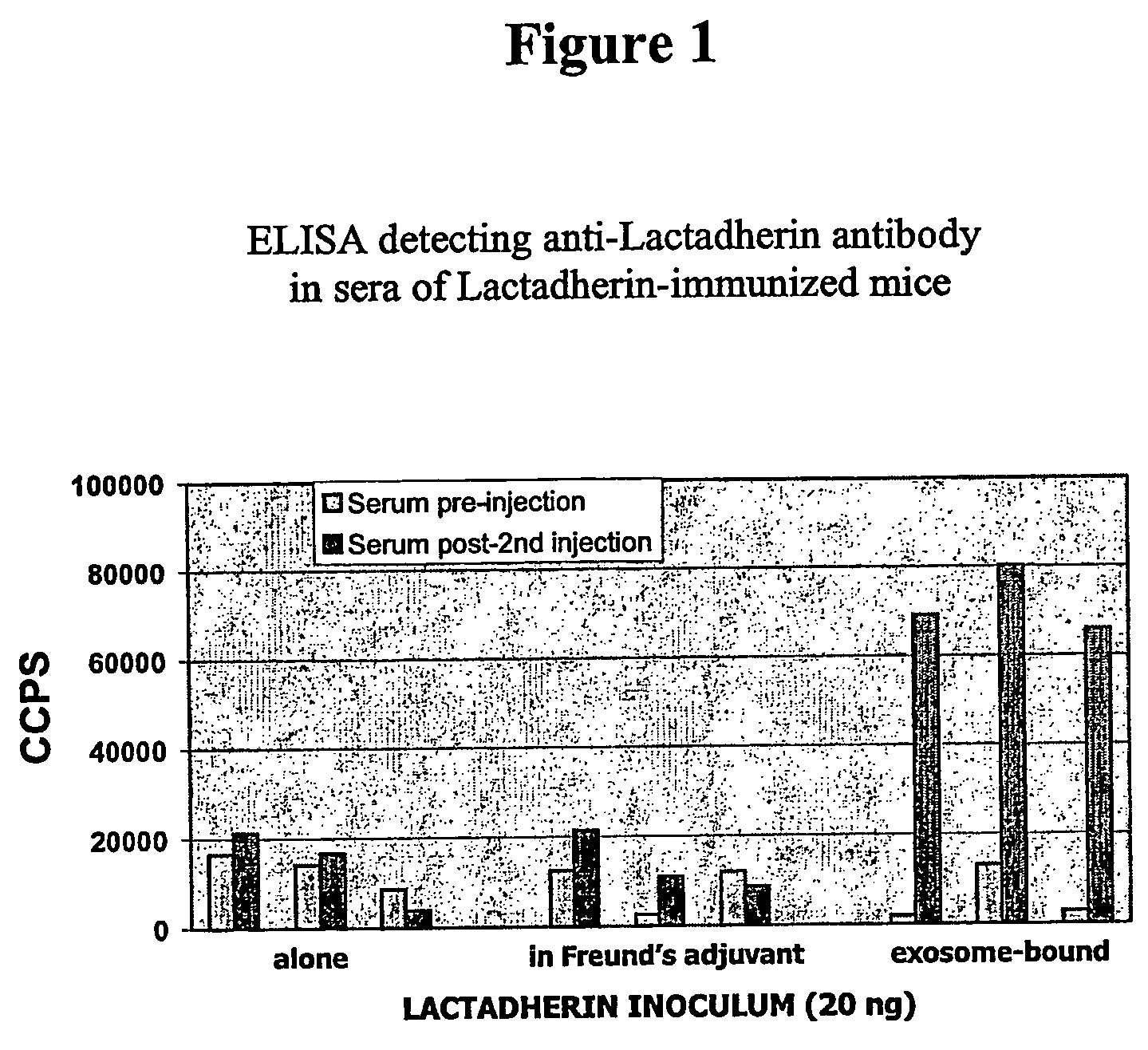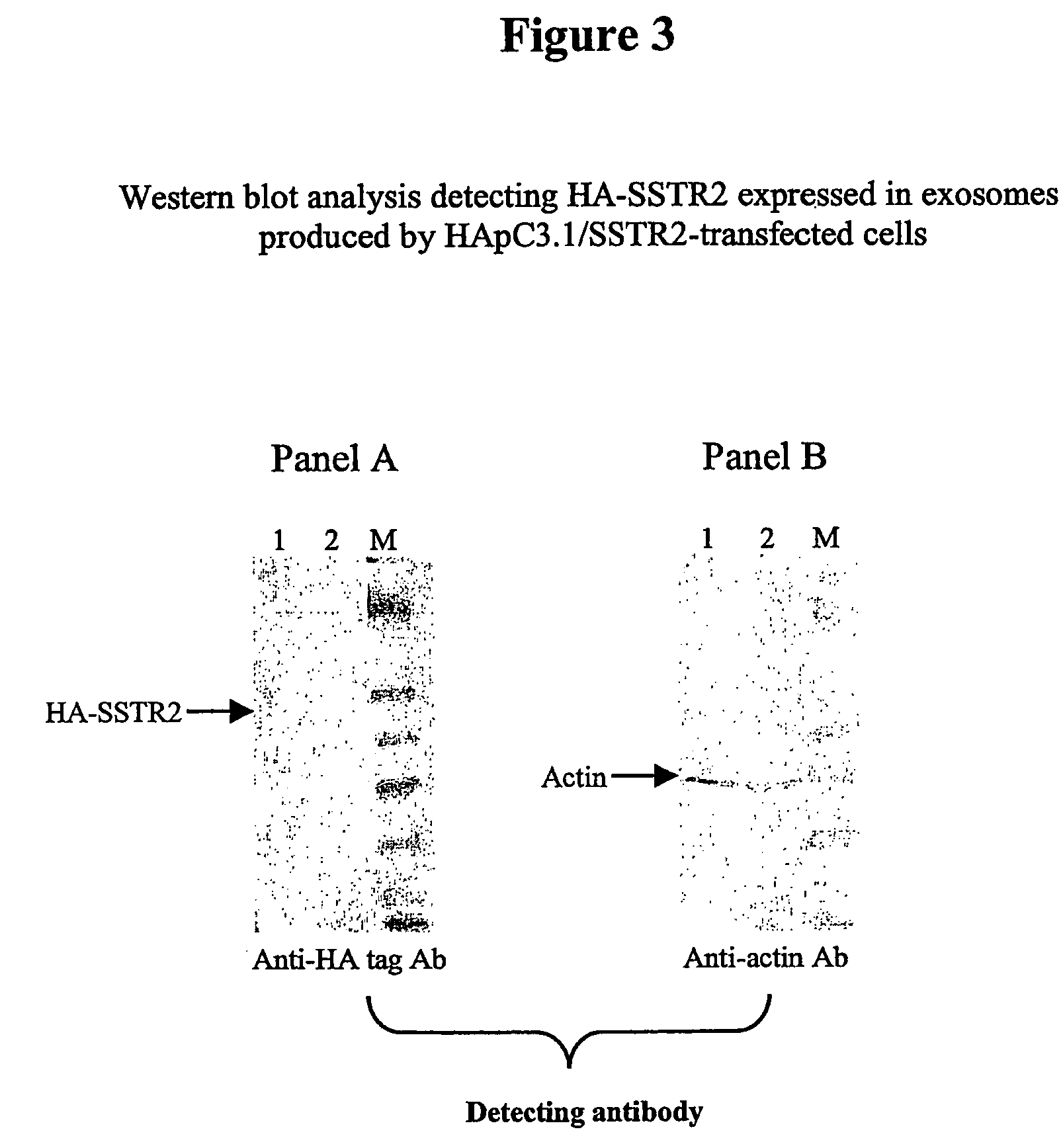Methods and compounds for raising antibodies and for screening antibody repertoires
a technology of antibodies and antibodies, applied in the field of methods and compounds for raising antibodies and for screening antibody repertoires, can solve the problems of rare antibody-producing cells with the desired antigen specificity loss, difficult to obtain soluble cd40l, and the basic method of preparing monoclonal antibodies has several limitations
- Summary
- Abstract
- Description
- Claims
- Application Information
AI Technical Summary
Problems solved by technology
Method used
Image
Examples
example 1
Exosomes are Potent Novel Vehicle for Raising Antibodies
[0148] Nine Balb / C mice were arranged in three immunization groups of three mice. Each mouse was immunized intraperitoneally with either ˜20 ng recombinant human Lactadherin in PBS (Group 1), ˜20 ng recombinant human Lactadherin in a 1:1 PBS / Complete Freund's Adjuvant mix (Group 2) or recombinant WEHI exosomes containing ˜20 ng human Lactadherin in PBS (Group 3).
[0149] Human recombinant Lactadherin was prepared from recombinant exosomes produced by CHO cells transfected with the plasmid pcDNA6hLactlf / His encoding the full-length recombinant human Lactadherin fused to a (His)6 tag (SEQ ID No. 2). pcDNA6hLactlf / His was prepared as follows. Two overlapping fragments of human Lactadherin cDNA were amplified from hematopoietic cell-derived cDNA using primer pairs LTDNf15(SEQ ID No. 3) / LTDNr8(SEQ ID No. 4) and LTDNf2(SEQ ID No. 5) / LTDNr13(SEQ ID No. 6), respectively. LTDN / f15 and LTDNr13 were extended at their 5′ end to include a H...
example 2
Method for the Generation of Exosomes Expressing Recombinant Membrane Proteins
[0154] The cDNA encoding the Somatostatin receptor (SSTR2), a G Protein-Coupled Receptor (GPCR), and derived from human brain RNA (Clontech, CA) was amplified by PCR using the primers SSTR2f1 (SEQ ID No. 7) and SSTR2r2(SEQ ID No. 8). The primers contained 5′ end extensions with a Hind m restriction site for SSTR2f1 and a Not I restriction site for SSTR2r2. Following digestion with Hind m and Not I, the PCR product was cloned into HApC3.1, a modified pcDNA3.1 (Invitrogen, CA) to prepare the expression vector HApC3.1 / SSTR2 (SEQ ID No. 9). HApC3.1 contains a HA tag-insert (SEQ ID No. 11) that was obtained synthetically (Genset, CA) and cloned into pcDNA3.1 between the Nhe I and Hind III sites of the vector. The HA tag encodes an initiation codon followed by a stretch of codons derived from the hemagglutinin antigen sequence and HApC3.1 / SSTR2 encodes HA-SSTR2, a recombinant SSTR2 with the HA tag at its N-term...
example 3
Method for the Generation of Exosomes Expressing Recombinant MHC I / Peptide Complex
[0160] The a chain of Human Leukocyte Antigen (HLA) A201 cDNA derived from A2-positive human leucocytes by reverse transcription was amplified by PCR using the primers HLA2f1 (SEQ ID No. 17) and HLA2r2 (SEQ ID No. 18). The primers were extended at their 5′ end to contain a Hind m restriction site for HLA2f1 and a BstB I restriction site for HLA2r2. The PCR product was digested with both Hind III and BstB I enzymes and ligated into pcDNA6-Myc / His that was precut with Hind III and BstBI I to yield pcDNA6-A2-Myc / His (SEQ ID No. 19).
[0161] Similarly, the β chain of HLA (β2-microglobulin or β2M) sequence was amplified by RT-PCR using the primers p2-MICfl (SEQ ID No. 20) and p2-MICr3 (SEQ ID No. 21) and was cloned into pcDNA6-Myc / His to yield pcDNA6-p2M (SEQ ID No. 22). The P2M insert in pcDNA6-p2M was then sub-cloned into pcDNA3, which contains a different antibiotic resistance gene than pcDNA6. For this ...
PUM
| Property | Measurement | Unit |
|---|---|---|
| pH | aaaaa | aaaaa |
| temperature | aaaaa | aaaaa |
| pH | aaaaa | aaaaa |
Abstract
Description
Claims
Application Information
 Login to View More
Login to View More - R&D
- Intellectual Property
- Life Sciences
- Materials
- Tech Scout
- Unparalleled Data Quality
- Higher Quality Content
- 60% Fewer Hallucinations
Browse by: Latest US Patents, China's latest patents, Technical Efficacy Thesaurus, Application Domain, Technology Topic, Popular Technical Reports.
© 2025 PatSnap. All rights reserved.Legal|Privacy policy|Modern Slavery Act Transparency Statement|Sitemap|About US| Contact US: help@patsnap.com



